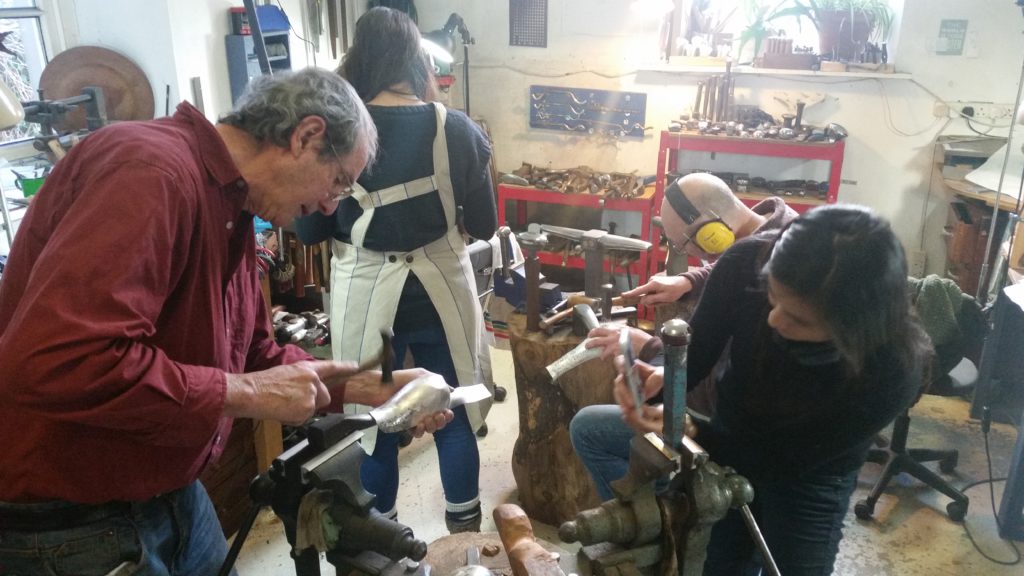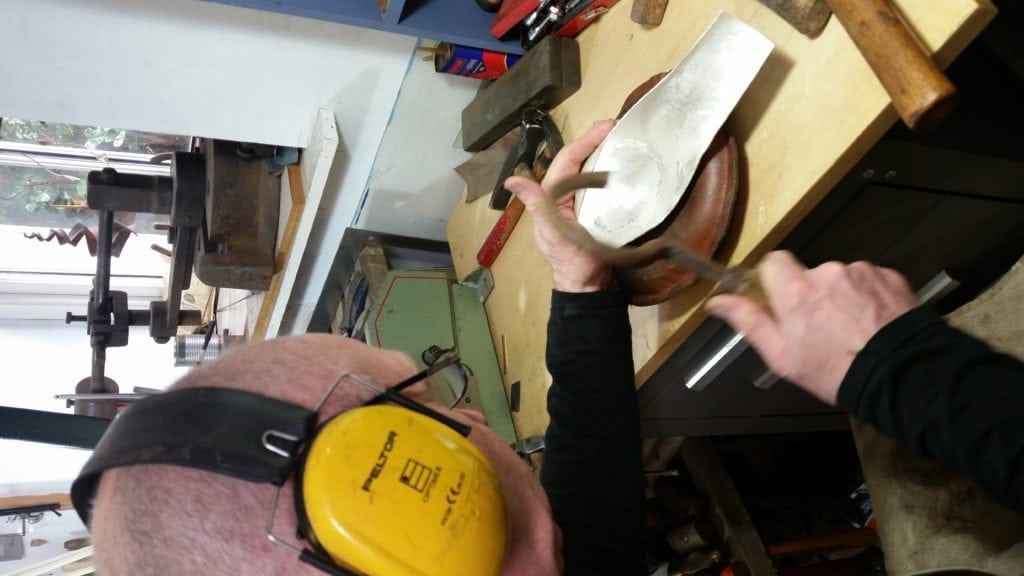Is silversmithing at risk?
UK jewellers are reporting a silversmithing skills shortage, raising concerns about the viability of its future as a craft skill in Britain. But what can be done to prevent its collapse? ALESSANDRO CARRARA finds out

Register to get 1 free article
Reveal the article below by registering for our email newsletter.
Want unlimited access? View Plans
Already have an account? Sign in
“It has become very difficult for many silversmithing workshops to find new staff today”, says silversmith Richard Fox. He says this is because large UK large workshops have closed down, changing the environment and leaving smaller atelier sized firms that “haven’t got enough resources” to take on and train new apprentices.
Fox runs a small designer bespoke silversmithing jewellery company, which he set up with his wife. “As my company grew,” he says, “it became very difficult to find people because a lot silversmithing companies bizarrely were going out of business. Then the staff were so old they would retire, so there was no new blood coming into the industry.” He adds that for many years it was difficult to find qualified staff skilled particularly with silversmithing, and that it soon came “progressively worse” as some of the necessary skill bases were being lost in education.
He says that, to a degree, the issue is being addressed with the apprenticeship course run by the Goldsmiths company and the Goldsmiths centre, which creates around 10 young graduates per year. “But of those 10 we are lucky to get one or two that will turn to silversmithing,” he adds.
The result is a potential silversmithing skills shortage. Speaking to other jewellery professionals has confirmed the need for new, robust education programmes that can entice ‘new blood’ into the industry and teach practical, marketable silversmithing, ensuring that these skills aren’t lost to future generation.
Apple Nooten-Boom, a qualified gemologist, goldsmith and a specialist in precious metal casting, says what there has also been a “massive cultural shift” in society specifically as regards its usage of silverware. He says the rise of cheap importation, cheaper overseas labour and consequently British companies shifting their manufacturing abroad has caused the market and the costs of products to drop decisively in recent years.
There is still a small demand for silverware, with the the average volume of hallmarked silver pieces having risen by 29% to 425,631 in January 2018, compared with 330,067 the previous year. But Nooten-Boom argues that now it tends to be from the very wealthy that want special, custom made pieces. He says: “There are still silversmiths capable of doing that kind of work, but in terms of volume it is just a shadow of what the demand there used 30 – 50 years ago.”
With this in mind he agrees that we are definitely on “the cusp” of a silversmithing skills shortage. He thinks that the issue is to do with silversmiths not being given the opportunities for proper training after education. He adds: “The workshops that used to exist have gone and this is where the next generation comes up against a brick wall.” The Goldsmiths Centre in London does offer traditional silversmithing and goldsmithing courses, but Nooten-boom says: “After you have done your one year training at the Goldsmiths Centre, where do you go to continue to learn and hone your skills?”
 He explains how complex the process for silversmithing can be, so it’s important that graduates get the opportunity to work in an actual silversmithing environment. “There is all the equipment for bringing it together, making sure it doesn’t twist and distort during the soldering operation. You need to have specialist polishers, because polishing silver and getting it right is not easy. You to make sure you don’t leave a firestain in the silver, because otherwise it won’t polish up,” he explains.
He explains how complex the process for silversmithing can be, so it’s important that graduates get the opportunity to work in an actual silversmithing environment. “There is all the equipment for bringing it together, making sure it doesn’t twist and distort during the soldering operation. You need to have specialist polishers, because polishing silver and getting it right is not easy. You to make sure you don’t leave a firestain in the silver, because otherwise it won’t polish up,” he explains.
In response to the potential skills shortage the Contemporary British Silversmiths and Goldsmiths’ Centre have partnered to create a practical skills training programme with the mission statement “[to] protect and promote excellence in British silversmithing skills”. It began life as a one-week pilot course developed by Rauli Higson, which was taught by retired silversmith Tony Bedford.
The Contemporary British Silversmiths found early success and decided quickly realised that there was scope to turn the scheme beyond into a much larger programme. However, the group needed a partner to help garner sufficient attention, with the end game a three-year programme that leads onto a graduate course.
Sally Dodson, programme manager for the CBS skills training programme, says: “This year we are doing five one-week courses, and what is unique about the programme is that it should become self-fulfilling. We are taking two people who have been beneficiaries of the course so far to go and teach the graduate course later on in the programme. So the idea is that we are making sure that these skills are passed down the chain.”
She adds that it has had a positive response. “We have just now finished our third course, so we have already identified two tutors to teach our graduate course. It’s been really positive and we are looking forward to seeing the exciting work that’s going to come about because of the training.”
Dodson says that silversmithing requires such a complex skills base that students who want to take it up are often held back by a “lack of experience” – many have not done much practical silversmithing during their education. “Confidence is a huge factor,” she adds, “and in the survey that we did at the start of the CBS skills training programme, gaining confidence was cited as the top reasons why silversmiths wanted more specialist training. To encourage more young people to take it up as a career choice it has to be about building the confidence that they can do these skills. In addition to reassuring them that there are still successful silversmithing business out there.”
However she believes that it is also important to look at the future role silversmithing can play in 2018 and beyond. “Traditionally when people think of silversmithing they might think of silversmiths making small tableware. But these days contemporary silversmiths aren’t doing that at all, they are working with architects, with designers, with the fashion industry, so there’s so much cross over into other areas. I think it’s really important in terms of innovation for the industry that you’ve got access to that skills base.”
“Silversmithing skills, like any craft skills, can’t just be learnt from books. To keep the craft going we need to act now before the skills are lost.”
The Crafts Council, a development agency for contemporary crafts in the UK, estimates the crafts industry contributes £3.4bn to the UK economy. Dodson says that is where silversmithing sits in the “wider picture”, pointing out that it’s very important to “upskill” the trade and create more commercial viability. In regard to promoting the British goods over imported items, Dodson says emphasising the quality of skills and design that is unique to Britain is key to getting PR exposure. “We need more news items, more selling opportunities and the industry and the smaller businesses need to get together and promote us as a whole.”
Fox insists that “bigger and better” things will come and he is hopeful that more people will want to come into the industry thanks to the new course. While he acknowledges that the jobs are there, he notes that there aren’t enough businesses doing it, so currently, he is “snowed under” with work. “It is a wonderful position to be in”, he laughs, “but if you haven’t got the people to keep up with the demand that’s where the problems arrive.” He concludes, “Customers will go elsewhere, to another country, so that is the issue we are trying to address.”







